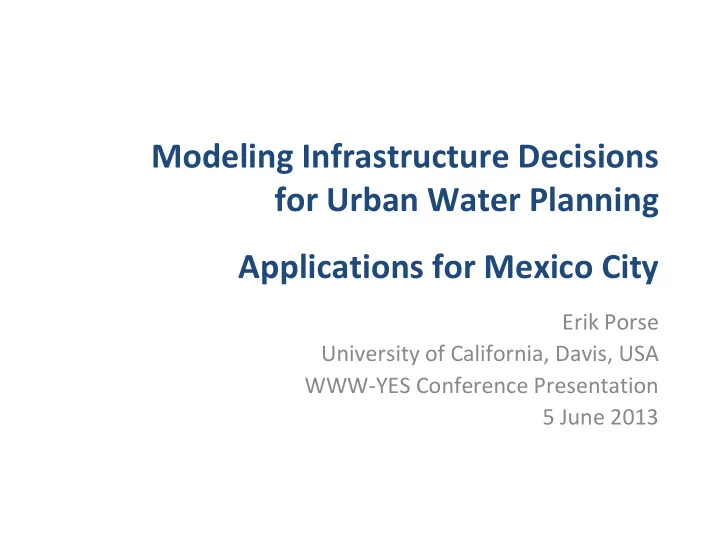

Modeling Infrastructure Decisions for Urban Water Planning Applications for Mexico City Erik Porse University of California, Davis, USA WWW ‐ YES Conference Presentation 5 June 2013
Models • Used to understand systems and processes • Decision models – Search through possible combinations to identify good solutions – Optimization models: search all available solutions • Linear, Non ‐ linear • Mixed ‐ integer • Dynamic – Heuristic models: focus search on favorable solutions • Genetic algorithms • Simulated Annealing Usefulness of models lies in the insights provided for system function and operation, not absolute numerical results
Optimization Modeling • Assess “best” solutions to complex problem sets • Theory and procedures developed over decades – Growth of operations research • Adopted as practice in many fields – Transportation planning – Water resources – Electricity and telecommunications • Necessary Criteria – Define goal or objective – Define variable inputs and equations for relationships – Identify Constraints
Two ‐ Stage Linear Programming • Probabilistic mathematical model useful in planning • Two stages of decisions – Initial actions – Subsequent “recourse” actions – Balance costs and predicted damages • Applications – Events where an initial decision must be made under uncertainty, and subsequent actions are possible – Water resources: • Flood planning • Water demand management
Chapter 6: Mexico City Basin Mexico City and Water Research Objective: Use planning models to assess tradeoffs in cost and performance of water infrastructure options for the Metropolitan zone of Mexico City 6
Applying a Two ‐ Stage Model • Probabilistic, two ‐ stage decision model for infrastructure and planning decisions in Mexico City – Long ‐ term decisions: Municipal and water supply infrastructure • Supply pipelines, treatment plants • Injection wells, infiltration basins • Demand management, rainwater harvesting, water reuse infrastructure, subsidies – Short ‐ term actions: Municipal and user actions to mitigate shortages, subsidence, and water quality issues • Supply outages and damage costs • Water trucks • Household reuse
Chapter 6: Mexico City Basin Municipal Water Balance • Water balance calculation Water Supply Use & Losses Water Out Imports water supply pipes Demands expansion costs per capita use Extraction Recharge pumping costs leakage System Outflows __ = Precipitation Runoff WW treatment & Drainage Canals Municipal Reuse injection direct potable reuse WW treatment & Household Actions infiltration water trucks Evaporation rainwater harvest reuse 8
Approach • Literature review and interviews • Identify possible initial actions and costs (long ‐ term) – Capital ‐ intensive • Identify possible subsequent actions to meet demands (short ‐ term) – Municipal and household • Parameterize likelihood of shortage events – Possible causes: rainfall, water demands, climate variability • Seek to identify tradeoffs in: – Long ‐ term vs. short ‐ term – Distributed vs. centralized
Framework for Potential Actions Long ‐ term and Short ‐ term Actions, categorized in relation to current approaches Landscape Long-Term Actions Centralized Innovative control policies, with some broad public public education engagement Import/Convey Water shortages Business as lead to action, Usual Information requirements Trucking Capture and Reuse Short-Term Actions 10
Progress • Literature review and existing data collection • Fieldwork interviews • Data collection – Hydrology – Groundwater data – Water balance calculations – Household water use • Begin with broad system view – Apply known variables at appropriate scale to identify data gaps to collect or parameterize • Consider case ‐ study basins
Outcomes and Limitations • Develop a hydro ‐ economic model for water management in the Basin of Mexico considering environmental factors • Explore tradeoffs in various strategies – Identify least ‐ cost combinations of actions • Data needs and applicability – Articulate relationships between variables – Quantify costs, potential damages, and challenges – Practitioner acceptance • Consider parallel cases of urban water resources development Incorporating expertise of system managers and researchers is critical to understanding any system
Erik Porse Ph.D. Candidate + REACH IGERT Trainee Civil and Environmental Engineering University of California, Davis, USA eporse@ucdavis.edu +1 703 835 5381 13
Recommend
More recommend